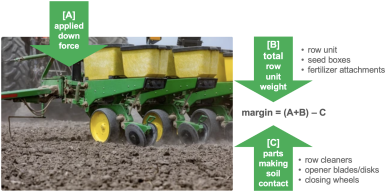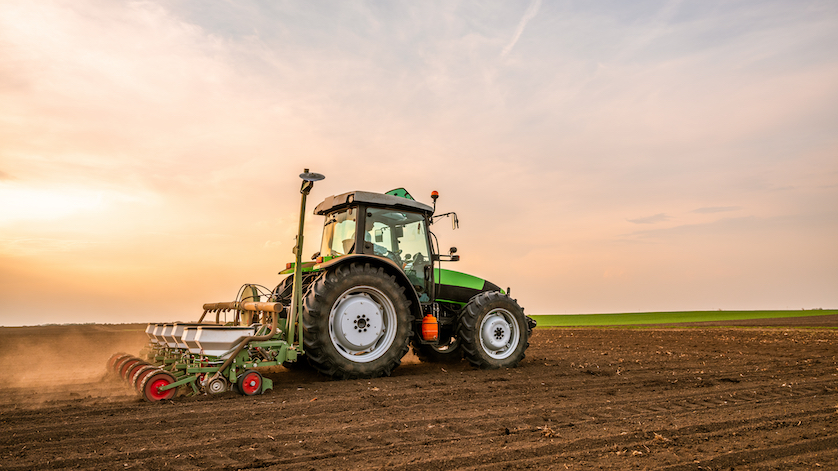
Downforce systems in agricultural planters optimize uniform emergence by cutting consistent seed furrows. WIKA specializes in working with OEMs to manufacture customer-specific load cells that fit seamlessly into their machines’ unique designs.
Precise downforce control is essential in highspeed planters. Without it, the row units aren’t able to make good contact with the soil as the machinery travels across fields. Setting the correct downforce margin, which varies according to each field’s current conditions, is key to achieving the type and depth of seed furrow that leads to uniform emergence and, thus, optimum crop yields.
The Role of Force Transducers in Downforce Planters
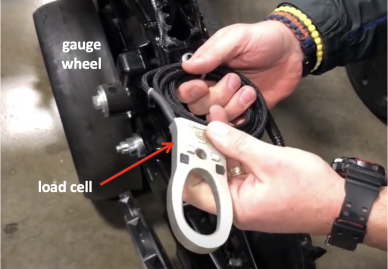
A load cell in a downforce system applies the proper force to the planter’s gauge wheels to cut the optimal seed furrow.
In a planter’s downforce system, loads cells are small but mighty components that make contact with the gauge wheel to ensure proper seed-to-soil contact. The ideal seed furrow has three main characteristics:
- Sufficient depth, depending on the seed type
- Consistent depth for uniform emergence
- Firm sidewall that won’t collapse and create air pockets, which prevent that crucial seed-to-soil contact for proper germination.
A downforce system applies the additional force necessary so that the opener blades or disks can cut a well-defined furrow at a sufficient and consistent depth. Too little downforce could mean crumbling furrows (thus, air pockets) and row unit hopping (leading to uneven seed spacing and varying seed depth). If the hopping is bad enough, the openers could even rise out of the ground and deposit seeds on top of the soil.
However, excessive downforce would compact the furrow so that it hinders plant growth, as the roots would have a harder time penetrating the soil and getting the nutrients they need. Too much downforce also causes excessive wear and tear on the components that make contact with the ground, such as openers, bearings, sheer rivets, and hubs.
Downforce Systems Actively Maintain the Margin
An active downforce system maintains the necessary force on the planter gauge wheel to cut the ideal seed furrow. The force, or weight, applied to the gauge wheel is called the margin and is calculated by the difference between two opposing forces.
The downward force is the additional weight applied by the active downforce system [A] and the total weight of the row unit [B]. The upward forces are all the components that make contact with the soil [C], creating resistance.
For example, if the total weight of the row unit [B] is 200 lbs., the downforce system [A] applies an additional 100 lbs. and the soil penetration resistance [C] is 200 lbs., then the margin is 100 lbs. In other words, the total force on the gauge wheel to obtain the ideal seed furrow is 100 lbs.
margin = (100 + 200) – 200 = 100
As another example, if the total weight of the row unit [B] is 180 lbs., the downforce system [A] applies an additional 50 lbs. and the soil penetration resistance [C] is 150 lbs., then the margin is 80 lbs.
margin = (50 + 180) – 150 = 80
The active downforce system should come within at least 97% of the margin for proper planting. The margin changes according to several factors:
- Field conditions – soil density, moisture, till vs. no-till, etc.
- Planting speed – higher speeds require more downforce to keep the gauge wheel in good contact with the soil
- Amount of seed in seed boxes (relevant in box planters)
Drier and more compact soils require higher margins. Some advanced planters can even remove weight (uplift) from the row unit, an important feature when working with very soft soils that offer little resistance.
Downforce Electronic Feedback System
To maintain the target margin, a load sensor measures the force on the gauge wheel and sends this information to a controller. The controller then communicates the proper downforce to the row unit parallel arm actuators, which then adjust the downforce. The system continuously monitors the target margin and adjusts the downforce based on soil conditions, planting speed, etc.
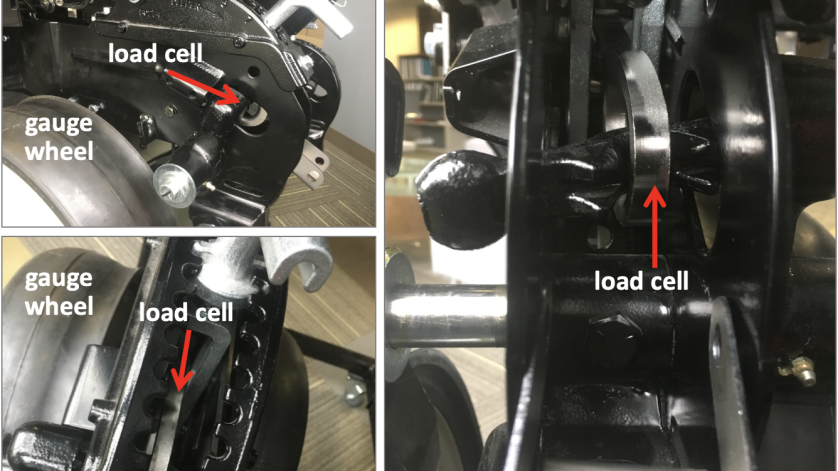
[clockwise from top left) Side view, rear view, and top view of the load sensor in a gauge wheel assembly
Custom Load Sensors for OEMs’ Downforce Control Systems
Every machine manufacturer has their own design for downforce planter systems, thus each has their own unique design for the load sensor that mounts to the gauge wheel for force measurement and control. WIKA works closely with OEMs to supply load cells to their specific design requirements, but most designs revolve around three WIKA models:
Here are just a few of the many customizations that WIKA offers:
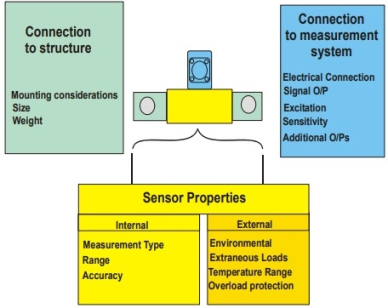
Customization options for load sensors
Connection to the mechanical structure
- Mounting considerations
- Size
- Weight
Connection to the measurement system
- Electrical connector or cable outlet
- Output signals – voltage, current, CANopen, SAE J1939
- Excitation and sensitivity
Load cell internal properties
- Measurement type – compression, tension, or both
- Measurement range
- Accuracy – nonlinearity, repeatability, hysteresis, etc.
Load cell external properties
- Environmental considerations
- Weather protection
- Corrosion protection
- Material: stainless steel, steel, etc.
- Resistance against shock, vibration, electromagnetic interference (EMI), radio frequency interference (RFI)
- Extraneous loads
- Temperature range
- Overload protection
WIKA manufactures force sensors in facilities around the world, including in the United States; the production location will depend on which one provides the greatest benefit to our customers. If certain procedures have to be performed in the U.S., we can accommodate those requests. In addition, WIKA USA has local engineers and field technicians to support the design and prototype development of OEM load cells.
WIKA USA, Smart Force Solutions for OEMs
It’s not always easy to choose the right load cells for your agricultural machinery’s systems. Knowing how to customize these force sensors can also be an issue. For durable OEM force sensors with a long and reliable service life, contact the product specialists at WIKA USA for personalized design assistance.
Products mentioned in this article:
• F5308 load pin
• F7301 tension link
• F2802 tension/compression force transducer


